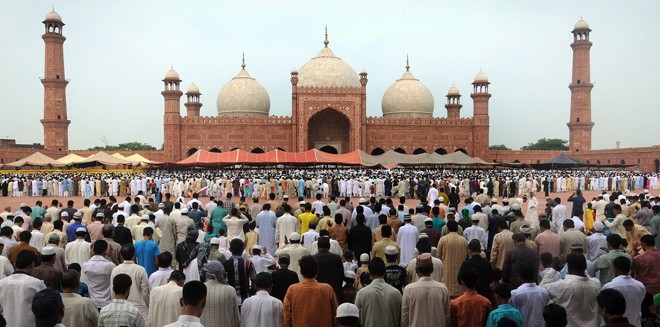

Books dealing with how the South Asian Muslims responded to their ‘decline’ after the War of Independence give a lot of importance to the last quarter of the 19th century. Reform movements and madrasas, embracing their new circumstances, tried hard to redefine what it meant to be a true Muslim. In order to re-invent South Asian Islam in the new situation, all authority was vested in foundational texts. The centrality of the Islamic foundational texts was the outcome of the literate tradition which was given added currency by colonial modernity.
Hence, a gradual shift from an oral to a literate tradition began, profoundly influencing all the variants of Islamic/Muslim instructions, be they traditional (Deoband, Darul Uloom Nadwatul Ulema etc.) or Modernist (MAO College Aligarh).
Modernity was the common ground found among otherwise disparate modes of Islamic dissemination. As a consequence, Muslim scholarship was also influenced by instruments of Modernist rationality. One very important outcome of the interface between Islam and modernity was the emergence of pan-Islamism, which came to be the principal determinant of the contours of political Islam and the manner in which it was articulated in South Asia.
It also created and then crystallised sectarian fissures among them. This contradiction has become the abiding feature of Islam, fracturing Muslim societies and polities into atomised social entities.
Pan-Islamism was first invoked by the Ottoman Sultan Abdul Hamid II in the 1870s who, instead of projecting himself as father of all his peoples alike -- Muslim, Christian, Jews -- and the leader of all the forces of westernising reform, prioritised another image for himself, that of the sultan of Sunni Islam, appealing to all (read Sunni) Muslims to rally round the Turkish throne in defence of the Umma.
Obviously the question of the Caliphate was very closely entwined with the whole discourse of pan-Islamism, which drew in Indian Muslims in the 1920s. The caliphate, the Sultan proclaimed, was a necessity of faith, transmitted legitimately from Hazrat Abu Bakr, the first Caliph of the Muslims to the Ottomans; he therefore was the shadow of Allah on earth, the executant of his decrees. All Muslims were obligated to obey him.
However, in the early years of his rule, Sultan Abdul Hamid embarked on a policy of modernisation which was all-encompassing. The system of justice was overhauled and he embarked on the centralisation of the administration through the newly introduced telegraph and railways. He also lent support to settled agriculture and discouraged, rather repressed, the Bedouin, and created schools both primary and secondary.
But as the reign went on, the politics of exclusion gradually became the centre-piece of his overall policy. The cosmopolitan character of the Ottomans gave way to a parochial and fissiparous outlook. Naturally, an era of political anarchy with revolts in the outer fringes of the sprawling empire must have a lot to do with that change. Interestingly, the pan-Islamic propaganda was carried out mainly through the medium of Arabic language and with the help of men of Arab origin like Ahmad Faris al-Shidyaq, Shaykh Muhammad Zafir of Mecca and Shaykh Abul-Huda al-Sayyadi etc.
Ironically that was despite the simmering discontent among the Arabs at that time.
What is more important is the impact that pan-Islamism had on the Muslim intelligentsia of the subcontinent. Jamal al-Din al-Afghani (1839-97) was the harbinger of this trend to which many adhered, like Iqbal and Maulana Azad. As mentioned above, the Khilafat Movement was the most vigorous expression of pan-Islamist sentiment in India. The two distinct realms of politics and religion seem to have collided with each other during the Khilafat Movement.
That movement, indeed, was a watershed in the way the politics of Islam subsequently unfolded with peculiar resonance in India and Pakistan. Not only did Jamiat Ulema-i-Hind emerge, later divided into several religio-political parties, but also the agitational style of politics gained currency in the 1930s and 1940s.
Such mode of politics pervaded the body-politic of Indian subcontinent from 1880s onwards. Majlis-i-Ahrar and Neeli Posh (of Maulana Zafar Ali Khan) are only a few illustrations of such political activism. Such figures like Abul Kalam Azad, Maulana Maududi, Hussain Ahamd Madni, Shabbir Ahmad Usmani, Salman Nadwi, Ataullah Shah Bokhari and Daud Ghaznavi came to political limelight by virtue of Khilafat Movement. Some of them figured quite prominently in such religiously-inflected movements like the 1953 Anti-Ahmadiya agitation.
What is worth mentioning is that the orientation of politics around Islam had become evidently pan-Islamic and also sectarian. All of these Ulema represented Sunni (puritanical) version of Islam. Even if some of the Shia individuals tried to join in, they could not but remain at the margins. Agha Khan, Syed Amir Ali and Raja Sahib Mehmudabad were among such people.
The argument, therefore, is that the evolution of Political Islam in the subcontinent from 1920s onwards was primarily informed by pan-Islamism but was embedded in the Sunni (exclusionary) ethos. In the 1940s when Islamists ventured to re-define Pakistan movement in the light of Islam, that fact remained largely obscured. If the pan-Islamism predominantly informed by the Sunni version was touted as the state ideology, it would lead to sectarian wrangling. But more importantly any ideology having pan-Islamist configuration would hardly have any correspondence with the exigencies typical to the nation state like Pakistan.
Such a sensibility found quite a fertile ground to flourish among the madrasas which have mushroomed in the length and the breadth of Pakistan, rendering the frontiers of a nation state absolutely irrelevant. Be it Chechnya, Syria, Iraq or Afghanistan, some Pakistanis, imbued with pan-Islamic sentiment, feel obligated to go and join the militants for the glory of Islam. Those who decide to join such transnational outfits like Taliban, Lashkar-i-Jhangvi and Lashkar-i-Taiba are also the victims of that ideology informed by pan-Islamism.